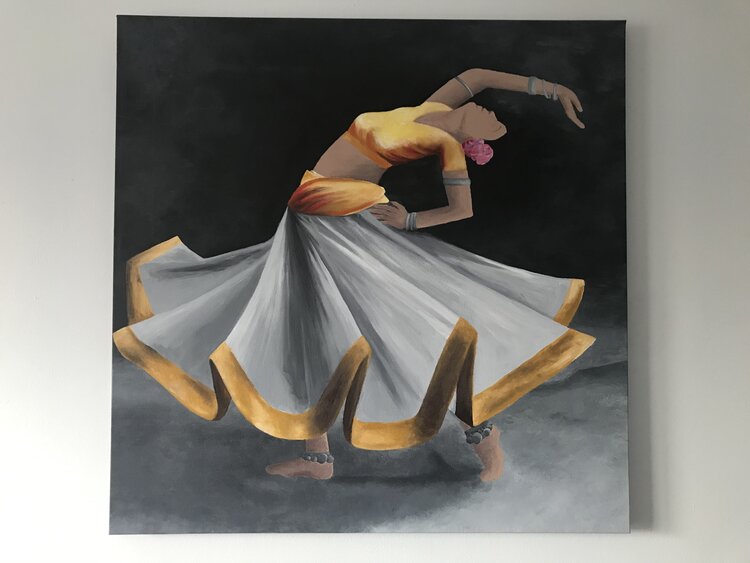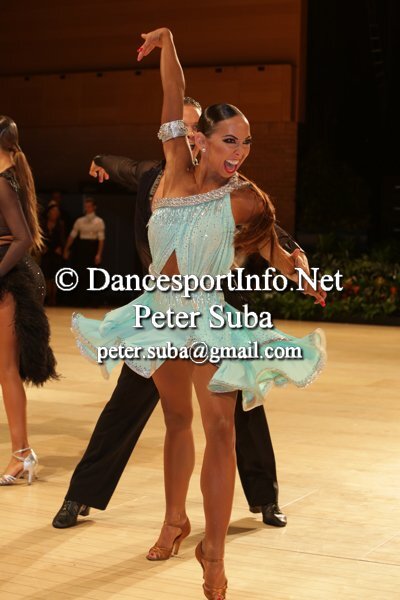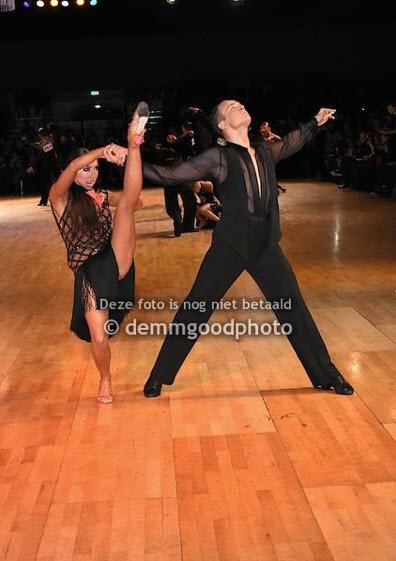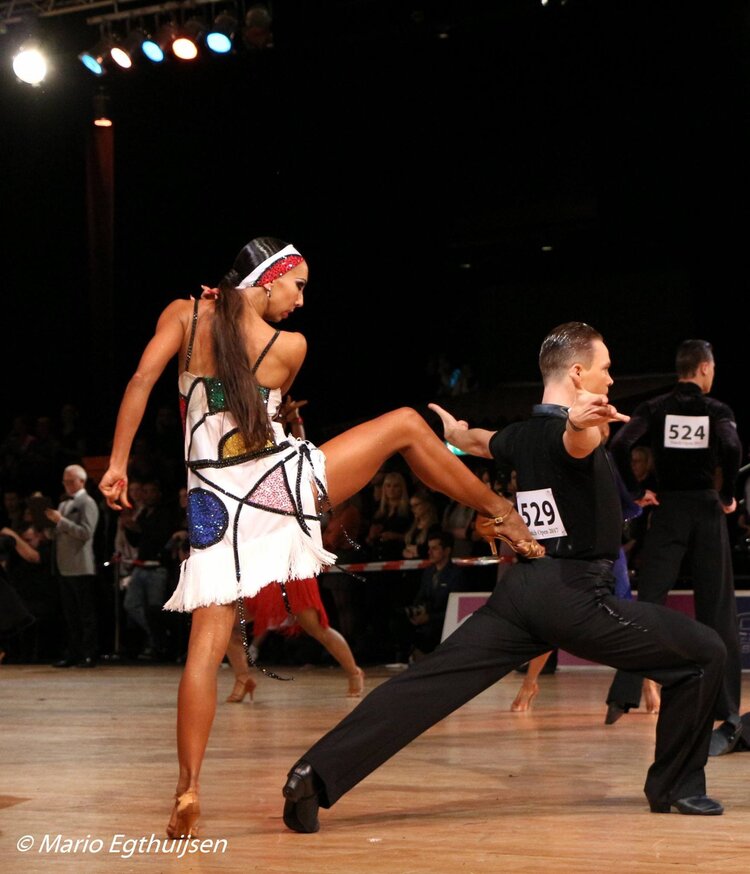Melanie Weiler is a competitive Latin Ballroom dancer. She started ballroom at the age of 18, unlike most of her competitors, who began dancing at a much younger age. With her dance partner, Ewoud Fidom, she has achieved considerable success on the dance circuit, winning the Dutch Open Rising Star category in 2017, being National Champions of Holland for four years (from 2016-2019), reaching the top 24 at Worlds in 2017, and making the top 48 in Blackpool three times (2016, 2018 & 2019).
Growing up, Melanie had many interests and hobbies, all of which were very different from ballroom dancing. “Throughout my early childhood, my grandfather exposed me to pottery, ceramics, painting and stained glass. He made all of those things for a living. He had a ceramics shop where he made things for local businesses to sell, and he taught classes at his shop. He was very artistic and always patient in guiding me and helping me to create beautiful things. Pottery, ceramics and stained glass require a lot of equipment, but painting was the side of it that I could maintain myself, even after he passed away. I still love to paint (pictured below). Also, before college I was very involved in soccer. I played for about 8-9 years. I think I loved the team aspect of the sport. My soccer team was very successful so we traveled around the state for tournaments. That was also a very fun part of it for me and the other girls.”



At the age of 18, Melanie headed off to college at UT Austin, where she was on the pre-medical track as an aspiring physician. It was there that she discovered her love for ballroom. “I started ballroom dancing at age 18, during my first year of college. I just saw a flyer for a ballroom dancing club that met in the evenings after classes. I was very excited about it from the beginning. I wanted to learn every style and to do it all. It was a really great experience from the outset. The club had a $40 membership for the whole semester. Once you were a member, all the classes were unlimited. I took almost every class that I could. Usually 5 days a week I was taking classes and then practicing on the weekends. I was a premedical student during my undergraduate years, so I was very focused on doing well in my classes. But otherwise I was dancing with every spare minute.”
When asked how she went from dancing as a serious hobby on the collegiate circuit to becoming an internationally-ranked competitor, Melanie replies, “Honestly, I never expected to have international doors opened for my dancing. I loved [ballroom] very much but I was also still devoted to my studies. Things shifted, however, between my sophomore and junior years of college. I was home in Dallas for a summer internship. I was looking for higher level teachers of the Latin style and I found a studio in Dallas with teachers who had world titles. I remember I couldn’t wait for the class. I started going to a few group classes with them and I think it was my first or second class when I met Natalja Panina. I could see how passionate and knowledgeable she was and how much experience was behind her teaching and dancing. After the class I was waiting around to see if I could speak to her. I remember I couldn’t find her in the studio. I was waiting and waiting because I felt like I had to know her story and talk to her. Finally, I thought I had missed her and I left the studio. There she was, standing outside, with Arkadiy. She said hello and asked me what I planned to do with my dancing. She is the one who opened international doors for me. She helped me find a partner who was aiming for international success too and that’s when dancing really took off for me. The rest, I guess, is kind of history. Now she is a dear friend, teacher and mentor.”
In college, it was not easy for Melanie to balance dancing with the rigorous load of a pre-med curriculum, but with her grit, passion and determination, she made it work. “UT Austin was a really great experience. I loved studying and learning and the environment was perfect. When I started dancing through the university club, it was just thrilling on a different level though. At first, there definitely was a kind of pull back and forth between dancing and my prior pre-med track. I had put a lot of energy and time in to studying, keeping my grades up, preparing for the MCAT, internships, volunteer hours and other things that typical premedical students do. I was very devoted to it so, yes, making the decision to not continue on that track was a very big one for me. I was very in touch with my heart and spirit, though, and I knew that my love for dancing was overshadowing everything else. I knew I wanted to dance. I was also lucky to have the support of my parents at that moment. I remember when I asked them if they would be upset if I went for dancing. They both told me to follow my heart. I think my dad said something like, ‘Well heck girl, if I had the chance to play semi-pro or pro baseball I definitely would have gone for it!’ That really helped me to make the jump and follow my passion. After that, there was a pretty big learning curve for me. Like I said, I had to learn to dance but also learn how to manage it as a career, as a teacher, a competitor and as a professional.”
Looking back on her time at UT Austin, Melanie believes that her education did not hinder her dancing, but rather enhanced it, shaping her into the artist she is today. “I think that the more you know, the more you have to work from. In my personal opinion, dancing should always be held as Art above Sport. This is a very big argument in the ballroom dancing industry because it does require a high level of fitness and stamina. But my personal belief is that it is an art. It’s not that you have to be highly educated to be a great artist, but I think it IS very helpful to have a broad base of knowledge and ideas to work from. I mean, dancing melts everything together. It involves your mind, your body, and certainly your soul. I think that’s why it is so good for people. You have to be fully engaged with your body and mind to dance well. Overall, I think expanding your mind and being open to bigger and more complicated ideas is important for personal growth, and that’s what education was and is to me. I think the mind is a very powerful tool—even more than the body. As dancers, we focus very much on the shape, form and movement of our bodies and sometimes neglect the development of our minds. I think education is a great way to sharpen and expand your mind and I think that has huge benefits to dancing as an art form.”

Melanie’s dance career took off when she moved to New York City after college to pursue her dancing seriously. “When I moved to New York is when my dancing truly became more serious. I mean, I took it seriously before that, but there was a lot for me to learn and a lot of things to catch up with. It’s quite a curve to catch up with competitors who have danced since they could walk and competed through their whole childhood. You have to learn how to dance on their level competitively, but also there’s a lot more to it than simply dancing. You need a lot of experience on many other levels too. Things weren’t immediate—it took a long time to adjust to New York. It took a while to find my way, to build up my teaching and build a good partnership. These things are very complicated and require a lot of dedication. I always set my eye on competition though. Through all of those changes I knew I wanted to compete and aim for the highest international level that I could reach.”
Starting dancing at a later age was one of the greatest challenges Melanie faced during her career. When asked if she ever doubted herself as a dancer, Melanie replies, “Of course. The beginning of my dancing was joyful and certainly naive in a way. I mean, you have to be a dreamer to go for a career in dancing. That early period was easier in a way, because I wasn’t that worried about what stage I was in personally or how that compared to other competitors. Sometimes, not worrying about what other people do is the best approach. As you grow and become more aware of what’s around you, however, that awareness is important but also a little dangerous. I’ve definitely walked down the road of comparing myself to others and feeling inadequate. But that road is really a trap. If you want to be your best, I think you have to walk down the path of seeking inspiration. Someone who gives me inspiration is Carmen, she also started at age 18 and look at her success. She is living proof that you can start late and still become a top professional.”
When asked what pieces of advice she would impart to dancers who started later in life, Melanie says, “This is a difficult question. I think that sometimes dancers who start later in life have a leg up in a way. Sometimes competitions and the repetition of things can be numbing. When things are new, it’s easy to be passionate. When things become more routine and you do them over and over, it’s harder to keep your eyes and your spirit fresh. I guess that in itself is kind of my answer– keep your passion and keep your eyes and your heart open.”
Melanie’s rise up the competitive ranks was a combination of many factors– passion and hard work, opportunity, sacrifice. “Well, I think my improvement is certainly a combination of many different things. Probably, the first of all of them is just my motivation and desire. Now that I am a teacher with some years under my belt, I also see myself and my students a little differently. Desire and motivation are very strong forces. The students I teach with low motivation levels—no matter their aptitude—learn and develop very slowly. Conversely, I’ve seen less talented but more interested and hard-working students outpace others. In my own situation, opportunity played a big part in getting me started. Without meeting Natalja and starting with my first international partner, I don’t know if all of this would have happened. Maybe I would have just continued dancing as a hobby instead of as a career. In any case, I don’t know a single successful dancer who hasn’t worked extremely hard, put in countless hours of practice, and also made huge sacrifices to achieve a higher level. So, I think in my case, whatever progress I’ve made must be a combination of my aptitude, my motivation, the opportunities that were presented to me and my work-ethic.”


A day in Melanie’s life as a dancer is as follows: “Dancers typically don’t wake up as early as the rest of the world, unless it’s for a competition or as a part of special training. Anything before 10am is considered very early for most dancers. That’s mainly because we tend to work until around 10-11pm. So, typically, I wake up around 9:30-10am. During the weekdays, I usually practice first from around 11 or 12:00 until around 3:00 or 4:00. My teaching schedule varies a lot from day to day but I’m usually teaching from around 4:00-10:00pm. The weekends are a little flip-flopped because I usually start earlier with teaching and practice afterwards. Traveling is a big part of the career because to be very successful, you need to dance the major international competitions. There are an ever growing number of competitions worldwide because I think the ballroom dancing industry is currently expanding, but overall the top competitions are mainly in England. The travel is usually the exciting part for me because most often it involves a competition. For me, competition is the cherry on top—it’s the part of the career that I enjoy the most. If we are lucky, we get to squeeze in a day or two for some sightseeing, but often times our travel is pretty in-and-out because we have to get back to work at home.”
Melanie’s trademark in dancing is her incredible hyperextended lines and beautifully arched feet. When asked how she was able to mould her body in such a way, Melanie replies, “Well, I just got pretty lucky with it. I think my bone structure is genetic from my mom’s side. Of course, I’ve spent a lot of energy and focus on foot and legwork in my practice. My first teachers were very passionate about legs and feet so the first 4-5 years of my dancing that’s pretty much all I worked on. It was good for me because I do believe good dancers are built from the feet up. As a result of that focus, however, I don’t think I really started to discover the mechanics, technique and coordination of the upper body until much later in my dancing.”
There are many things Melanie loves about being a dancer. “I enjoy the physical benefits, the creative aspects, the opportunities to travel and do what you love the most. Dancing requires you to be present in the moment and to constantly improve yourself spiritually and physically. It’s a journey of creating and recreating yourself. I think that this process—improving and growing and expanding— is the best thing about it. It’s wonderful to do something that anchors you to the current and present moment while also pushing you to be better in the next moment too.”
When asked what her favorite competition memory was, Melanie replies, “My favorite competition memory was in 2017 when we won the Rising Star in Dutch Open. It was exciting to win of course, but the reason it was so memorable was that my partner and I felt very positive and strong from the first to the last round of the comp. We really love the music at that competition and we always have a good time dancing there because of the atmosphere. It was kind of the perfect mix of all things that brought us to the feeling of just floating through the comp. My partner told me later that a fellow competitor he respected had told him that we looked completely outstanding, starting from the very first round. Honestly, on that day, I don’t remember trying to be outstanding or thinking about winning or placement at all. I think we were just lucky to get in the zone and have that perfect feeling on the day that nothing could touch us—it was just us playing around and enjoying the music. Another memory that’s very special to me was the time we first danced to a live orchestra in Blackpool. I remember we weren’t thinking about the orchestra before we stepped on the floor but when cha cha started I just remember that the live music gave me such a completely different feeling. It was very exciting. When the music is played by a live orchestra you get a feeling like it’s completely inside of you—like the vibrations of the sounds become a part of your body and your movement. Also, because the orchestra usually doesn’t play for the earlier rounds. Traditionally, it’s like a marker for when the higher level of the competition starts to begin. It was another outstanding memory because it was a very elevated experience on the floor.”
As for future aspirations for dancing, Melanie says, “I hope that I can become the best version of myself on the dance floor. I hope I can reach my highest potential before I retire from competition. I also dream of doing great show dances—the kind that inspire and move the audience deeply. I would love to experience the freedom of creativity that lies beyond the more strict and stereotyped structure of competitive dance. So I certainly want to become a better story teller on the floor and to be more creative and original in and through my dancing.”
What a story, what a journey, and what an incredible young woman and artist Melanie is. She is living proof that one need not begin the pursuit of dancing at an early age– or any activity, for that matter– in order to be successful in it. Passion, hard work, perseverance. Such can take you far in the pursuit of excellence, as Melanie has exemplified.

0 Comments